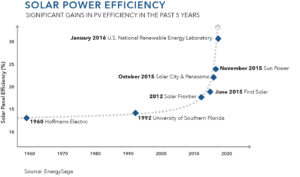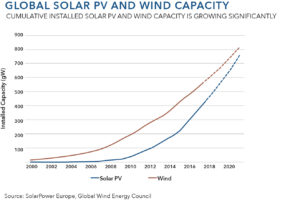The Evolution of Solar Technology
The key component for solar power generation is the photovoltaic (PV) cell, which is a panel that converts light into energy. There are different types of PV cells, and different arrangements that use lenses and mirrors to focus large areas of sunlight into tight beams, but the core PV technology has been around for decades.
Since early implementation in the 1970s and 1980s, costs have drastically decreased and efficiency has significantly increased, making solar a much more compelling technology. The solar industry has undergone remarkable growth in the last decade, due to both efficiency increases and cost reductions of PV cells. The global installed solar PV capacity has grown from around 5 GW in 2005 to approximately 307 GW in 2016.
In 2006 it cost $9 per watt of power generated by solar panels. As of 2015, that figure had dropped to approximately $3.79 per watt, and is reported to be around $3.57 per watt as of late 2016. The average cost of a standard 6kW solar home system—without subsidies—fell from $52,920 to $20,160 in the past decade. The very first solar cells were less than 1 percent efficient, as defined by the portion of sunlight that is converted to energy. By 1960, PV cells had achieved around 14 percent efficiency, which increased to 17.8 percent in 2012. Since then, the gains have increased rapidly. By 2015, Solar City, Panasonic, and Sun City all achieved over 22 percent efficiency. In January of 2016, the National Renewable Energy Laboratory announced it had achieved 29.8 percent efficiency. Continuing efficiency gains will reduce the cost and increase the commercial viability of solar power.
According to the Solar Energy Industries Association, the US-based solar industry has grown at a 60 percent compound annual growth rate over the past ten years. It employed nearly 374,000 Americans in 2016, up 25 percent from 2015. This is more employees than work in coal, gas, and nuclear energy combined, though it is still less than 20 percent of the size of the workforce of Walmart.
The consumer applications are also increasing in functionality and versatility, and decreasing in cost. As of February 2016, over one million homes in the United States have installed solar panels. According to Solar Energy Industry Association, the US added 125 solar panels per minute in 2016, around twice the rate of 2015. New consumer-friendly applications are emerging, such as Tesla’s Solar Roof product that looks remarkably like a normal roof and will be durable enough to be warrantied for the life of a house.
We commonly think of solar in terms of residential or small-scale commercial applications, but it is important to note that there are already major concentrated solar power generation facilities in operation. Two facilities in California—the Desert Sunlight Solar Farm near the Mojave Desert and the Topaz Solar Farm near San Luis Obispo—each have a capacity of around 550 MW. The Tengger Desert Solar Park in the Inner Mongolia region of China, also known as the “Great Wall of Solar,” has a projected capacity of over 1,500 mW.
The commercial and industrial applications of solar power extend far beyond large, government-funded solar plants. One of the key benefits of solar, which we will discuss in further detail, is that it can be built at different scales without sacrificing the economics significantly. Small generation facilities, or even panels on rooftops or above parking lots, can generate power in a cost-efficient fashion.
While solar PV technology is mature, it is obviously dependent on the availability of sunlight, so solar power is not a universally applicable solution. As with wind and other renewables, these technologies are best viewed as part of a holistic energy solution that includes both renewables and fossil fuels.
Join the Catalyst Monitor
Join our community, where we push out regular insights to help maintain situational awareness on technological and socioeconomic trends.





